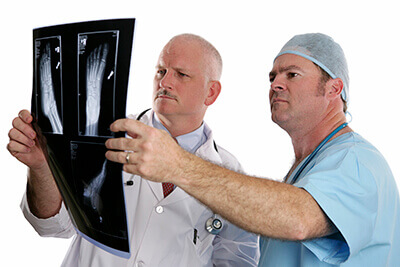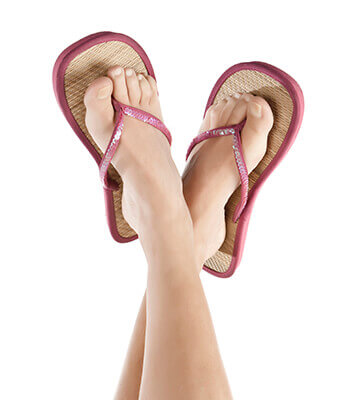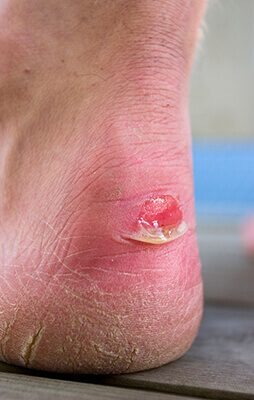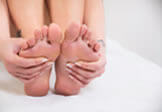





 While most people understand that podiatrists are foot doctors, many people still may not comprehend a podiatrist’s work and the various conditions a podiatrist treats. Various foot problems that many people experience and that a podiatrist can treat include plantar fasciitis, ingrown toenails, bunions, hammertoes, and flat feet.
While most people understand that podiatrists are foot doctors, many people still may not comprehend a podiatrist’s work and the various conditions a podiatrist treats. Various foot problems that many people experience and that a podiatrist can treat include plantar fasciitis, ingrown toenails, bunions, hammertoes, and flat feet.
Among the group who sought podiatric help, 88% reported a quick diagnosis and 76% received treatment that eliminated the problem. A third of the group said that their visits to the podiatrist exposed other health concerns, such as diabetes, circulatory issues, and nerve issues.
"It's not surprising to see how many people are affected by foot pain, when survey results show that we view our feet as the least important body part in terms of our overall health and wellbeing," said AMPA President Frank Spinosa. "Our feet are literally and figuratively the furthest things from our minds."
If you are experiencing pain in the feet or ankles, don’t join the stubborn majority refusing treatment. Feel free to contact our one of our podiatrists of Active Foot and Ankle Care, LLC. Our doctors can provide the care you need to keep you pain-free and on your feet.
What is a Podiatrist?
Someone would seek care of a podiatrist when they have suffered a foot injury or have common foot ailments such as: heal spurs, bunions, arch problems, deformities, ingrown toenails, corns, foot and ankle problems etc.
Podiatric Treatment
A podiatrist will treat the problematic areas of the feet, ankle or lower leg by prescribing the following:
A common podiatric procedure a podiatrist will use is a scanner or force plate which will allow the podiatrist to know the designs of orthotics. Patients are then told to follow a series of tasks to complete the treatment. The computer will scan the foot a see which areas show weight distribution and pressure points. The podiatrist will read the analysis and then determine which treatment plans are available.
If you have any questions please feel free to contact one of our offices located in New Jersey. We offer the newest diagnostic and treatment technologies for all your foot and ankle needs.
Read more about What is a Podiatrist.
 It is no secret that flip-flops are not the best choice of footwear for your feet. Flip-flops often cause a great deal of heel pain for those that wear them for an extended period of time. Teens are a group that usually doesn’t suffer from foot problems such as heel pain. However, as flip-flops and sandals have increased in popularity, more teenagers have been suffering from feet issues. If you choose to wear sandals, it is recommended that you select a pair that has strong soles and good arch support. Although sandals with thicker soles may not be stylish, is it important to wear them in order to avoid getting plantar fasciitis.
It is no secret that flip-flops are not the best choice of footwear for your feet. Flip-flops often cause a great deal of heel pain for those that wear them for an extended period of time. Teens are a group that usually doesn’t suffer from foot problems such as heel pain. However, as flip-flops and sandals have increased in popularity, more teenagers have been suffering from feet issues. If you choose to wear sandals, it is recommended that you select a pair that has strong soles and good arch support. Although sandals with thicker soles may not be stylish, is it important to wear them in order to avoid getting plantar fasciitis.
Flip-flops are not always the best choice of footwear. If you have any concerns about your feet or ankles contact one of our podiatrists of Active Foot and Ankle Care, LLC. Our doctors will assist you with all of your foot and ankle needs.
Flip-Flops and Feet
When the weather starts warming up, people enjoy wearing flip-flops. Flip-flops are comfortable, stylish, and easy to slip on and off, perfect for any summer beach goer. However, these shoes can cause harm to the feet.
How Can Flip-Flops Affect Me Long-Term?
Are there injuries associated with flip-flops?
Yes. Since flip-flops are relatively weak and do not provide the same amount of support as sneakers, people who wear flip-flops are more susceptible to injuries. On top of that, the open nature of the shoe makes your feet more prone to other problems, such as cuts and even infections. Common injuries and ailments include:
I like wearing flip-flops, are there safe alternatives?
When buying flip-flops, try to find ones that have sturdy soles and are made of high quality materials that will support for your feet. These flip-flops will cost more, but will also last longer as a result.
If you have any questions, please feel free to contact our office located in New Jersey. We offer the newest diagnostic and treatment technologies for all your foot and ankle needs.
Read more about Flip-Flops and Your Feet
 Blisters are a fairly common foot condition that can be easily prevented with a few simple steps. The first step is to always ensure the feet or kept clean to prevent any germs or bacteria from penetrating the skin. Wearing the right pair of socks can also help support the feet and reduce friction, which can create blisters. Applying bandages or bandaids to any already existing blisters can help reduce excess heat or additional friction that can exacerbate the blister.
Blisters are a fairly common foot condition that can be easily prevented with a few simple steps. The first step is to always ensure the feet or kept clean to prevent any germs or bacteria from penetrating the skin. Wearing the right pair of socks can also help support the feet and reduce friction, which can create blisters. Applying bandages or bandaids to any already existing blisters can help reduce excess heat or additional friction that can exacerbate the blister.
Blisters are prone to making everyday activities extremely uncomfortable. If your feet are hurting, contact our one of our podiatrists of Active Foot and Ankle Care, LLC. Our doctorswill assist you with all of your podiatric concerns.
Foot Blisters
Foot blisters develop as a result of constantly wearing tight or ill-fitting footwear. This happens due to the constant rubbing from the shoe, which can often lead to pain.
What are Foot Blisters?
A foot blister is a small fluid-filled pocket that forms on the upper-most layer of the skin. Blisters are filled with clear fluid and can lead to blood drainage or pus if the area becomes infected.
How do Blisters Form?
Blisters on the feet are often the result of constant friction of skin and material, usually by shoe rubbing. Walking in sandals, boots, or shoes that don’t fit properly for long periods of time can result in a blister. Having consistent foot moisture and humidity can easily lead to blister formation.
Prevention & Treatment
It is important to properly care for the affected area in order to prevent infection and ease the pain. Do not lance the blister and use a Band-Aid to provide pain relief. Also, be sure to keep your feet dry and wear proper fitting shoes. If you see blood or pus in a blister, seek assistance from a podiatrist.
If you have any questions, please feel free to contact our office located in New Jersey. We offer the newest diagnostic and treatment technologies for all your foot and ankle needs.
Read more about blisters on the feet
 There are many things that can cause heel pain, including heel spurs. Heel spurs are bone growths that occur on the heel. Another possible source of your heel pain could be Achilles heel, which is common in runners. Achilles heel occurs when the tendons that connect to the heel become inflamed. You can treat your heel pain by icing the heel, applying a compression bandage, and keeping it elevated. However if your pain does not go away after you treat it, you should see a podiatrist.
There are many things that can cause heel pain, including heel spurs. Heel spurs are bone growths that occur on the heel. Another possible source of your heel pain could be Achilles heel, which is common in runners. Achilles heel occurs when the tendons that connect to the heel become inflamed. You can treat your heel pain by icing the heel, applying a compression bandage, and keeping it elevated. However if your pain does not go away after you treat it, you should see a podiatrist.
Anyone can wind up suffering from heel pain. For more information, contact one of our podiatrists of Active Foot and Ankle Care, LLC. Our doctors will treat your foot and ankle needs.
Causes of Heel Pain
● Heel pain is often associated with plantar fasciitis. The plantar fascia is a band of tissues that extends along the bottom of the foot. A rip or tear in this ligament can cause inflammation of the tissue.
● Achilles tendonitis is another cause of heel pain. Inflammation of the Achilles tendon will cause pain from fractures and muscle tearing. Lack of flexibility is also another symptom.
● Heel spurs are another cause of pain. When the tissues of the plantar fascia undergo a great deal of stress, it can lead to ligament separation from the heel bone, causing heel spurs.
Why Might Heel Pain Occur?
- Wearing ill-fitting shoes
- Wearing non-supportive shoes
- Weight change
- Excessive running
Treatments
Heel pain should be treated as soon as possible for immediate results. Keeping your feet in a stress free environment will help. If you suffer from Achilles tendonitis or plantar fasciitis, applying ice will reduce the swelling. Stretching before an exercise like running will help the muscles. Using all these tips will help make heel pain a thing of the past.
With the advancements in technology and greater knowledge of how muscles and joints work, physical therapists can turn things around dramatically.
If you have any questions, please feel free to contact our office located in New Jersey. We offer the newest diagnostic and treatment technologies for all your foot and ankle needs.
Read more about Heel Pain
 A heel spur is an extra growth of bone that is caused as a result of irritation where the tendon attaches to the bone. Heel spurs often occur toward the inside or front of your heel. Many people think that heel spurs are the source of their heel pain, however this isn’t always the case. It is likely that these people have had the spur long before they experienced pain in their heel. If you have pain in your heel, consult your podiatrist for treatment.
A heel spur is an extra growth of bone that is caused as a result of irritation where the tendon attaches to the bone. Heel spurs often occur toward the inside or front of your heel. Many people think that heel spurs are the source of their heel pain, however this isn’t always the case. It is likely that these people have had the spur long before they experienced pain in their heel. If you have pain in your heel, consult your podiatrist for treatment.
Heel spurs can be incredibly painful, and sometimes might make you unable to participate in physical activities. To get medical care for your heel spurs, contact one of our podiatrists of Active Foot and Ankle Care, LLC. Our doctors will do everything possible to treat your condition.
Heels Spurs
Heel spurs are formed by calcium deposits on the back of the foot where the heel is. This can also be a cause from small fragments of bone breaking off one section of the foot, attaching it to the back of the foot. Heel spurs can also be bone growth on the back of the foot. Bone may grow in the direction of the arch of the foot.
Older individuals usually suffer from heel spurs. Pain sometimes intensifies with age. Heel spurs are known to cause a substantial amount of pain. One of the main associations spurs are related to is plantar fasciitis.
Pain
The pain associated with spurs is often times because of weight placed on the feet. When someone is walking their entire weight is concentrated on the feet. Bone spurs then have the tendency to poke and affect other boners and tissues around the foot. As the pain continues the feet will become tender and sensitive over time.
Treatments
There are many ways to treat heel spurs. If one is suffering from heel spurs in conjunction with pain there are several methods for healing. Medicines, surgery, and herbal care are some options.
For more information about Heel Spurs, follow the link below.
If you have any questions feel free to contact our offices inNew Jersey. We offer the latest in diagnostic and treatment technology to meet your needs.






